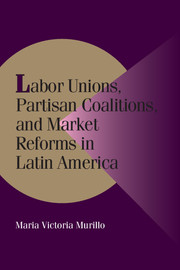Book contents
- Frontmatter
- Contents
- Abstract
- Acknowledgments
- List of Acronyms
- 1 UNIONS' DILEMMA: HOW TO SURVIVE NEOLIBERALISM
- 2 A THEORY OF UNION-GOVERNMENT INTERACTIONS
- 3 THE POPULIST PAST AND ITS INSTITUTIONAL LEGACIES
- 4 A TUG OF WAR: LABOR UNIONS AND MARKET REFORMS IN VENEZUELA
- 5 DIVIDED WE RULE: LABOR UNIONS AND MARKET REFORMS IN MEXICO
- 6 FROM PICKETS TO PRICES: LABOR UNIONS AND MARKET REFORMS IN ARGENTINA
- 7 MULTILEVEL COMPARISON
- 8 LABOR COMPETITION AND PARTISAN COALITIONS
- Bibliography
- Interviews
- Index
- Titles in the series
6 - FROM PICKETS TO PRICES: LABOR UNIONS AND MARKET REFORMS IN ARGENTINA
Published online by Cambridge University Press: 05 February 2010
- Frontmatter
- Contents
- Abstract
- Acknowledgments
- List of Acronyms
- 1 UNIONS' DILEMMA: HOW TO SURVIVE NEOLIBERALISM
- 2 A THEORY OF UNION-GOVERNMENT INTERACTIONS
- 3 THE POPULIST PAST AND ITS INSTITUTIONAL LEGACIES
- 4 A TUG OF WAR: LABOR UNIONS AND MARKET REFORMS IN VENEZUELA
- 5 DIVIDED WE RULE: LABOR UNIONS AND MARKET REFORMS IN MEXICO
- 6 FROM PICKETS TO PRICES: LABOR UNIONS AND MARKET REFORMS IN ARGENTINA
- 7 MULTILEVEL COMPARISON
- 8 LABOR COMPETITION AND PARTISAN COALITIONS
- Bibliography
- Interviews
- Index
- Titles in the series
Summary
The conversion of Peronism from populism to neoliberalism and the 1983 democratic transition closed half a century of political and economic instability in Argentina. After the overthrow of Perón in 1955, presidents did not complete their terms in office, and military coups marked their turnovers. Multiple devaluations of the exchange rate, mounting inflation, and erratic economic growth accompanied political instability, which turned toward violence with the emergence of guerrilla groups in the late 1960s. To halt this violence, Perón was permitted to return from exile and be elected president in 1973. He followed expansionary economic policies and further enlarged the public sector (Di Tella 1983, Sturzenegger 1991). After his death the following year, battles over economic policy – including a general strike called by the CGT – and urban violence escalated (Torre 1983). By 1976, the economy was in recession, the fiscal deficit had reached 15.1% of GDP, and the wholesale price inflation peaked at 499% (Frieden 1991: 189).
The military took power again in March of 1976, imposing a very repressive authoritarian regime, banning union and political activities, and implementing neoliberal policies. Its financial liberalization increased interest-rate differentials between Argentina and the rest of the world. High interest rates and an exchange rate that lagged behind inflation provoked an appreciation of the domestic currency, which with trade liberalization put pressure on manufacturing firms in the consumer-oriented import-competing sector and generated massive inflows of capital. Firms acquired dollar-denominated debt to keep their operations afloat or went bankrupt. The foreign debt grew three times between 1978 and 1981.
- Type
- Chapter
- Information
- Publisher: Cambridge University PressPrint publication year: 2001



